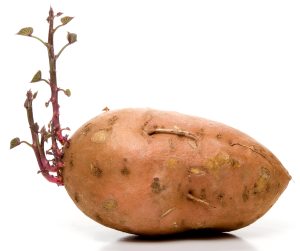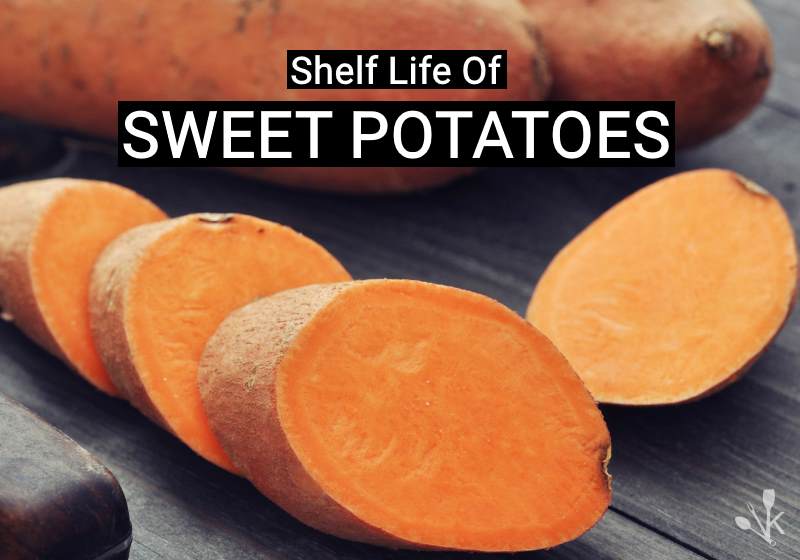Sweet potatoes are delicious, starchy root vegetables with a sweet taste, very distantly related to the common potato. It’s common to purchase a large bag full of these versatile vegetables to use over a long period, but you may be wondering, do sweet potatoes go bad? And how long can they be stored for?
The creamy, starchy texture of a sweet potato indicates they have a high water content; foods with more water inside tend to go bad more easily. So yes, sweet potatoes can go bad. Stored correctly in the pantry, they can last for around a month.
Sweet Potato Shelf Life
Sweet potatoes are available year-round through much of the United States. They oxidize or darken quickly, so you’ll get best results if you cook them shortly after peeling and cutting.

How long do cooked sweet potatoes last? For best visual characteristics, you’re safer to use them up quickly. Once cut and cooked, a sweet potato will darken simply due to air exposure.
- Raw sweet potato – kept on the countertop, sweet potato will go bad within one or two weeks. Stored correctly in the pantry, they should last for around one month. In the fridge, two to three months, and in the freezer up to eight months.
- Cooked sweet potato – should be consumed within three to five days if stored in the fridge, but can last indefinitely in the freezer. However, sweet potatoes will decline in quality after four to six months in the freezer.
- Canned sweet potato – unopened, this is best consumed within one year. Once opened, it should be stored in the fridge and consumed within seven days.
How To Tell If A Sweet Potato Is Bad
Your sweet potato shelf life can be shortened by poor handling.
One of the challenges in transporting a sweet potato is they can be chilled below the recommended 55 degrees Fahrenheit / 12 degrees Celsius. Then when they are put out on grocery store shelves, moisture condensation can form and encourage mold on sweet potatoes.
It’s easy to tell when a sweet potato is bad by checking for the following changes:
- Softness – an old sweet potato that is starting to spoil will become soft, starting from the ends. If left, it will become mushy and smell bad.
- Wrinkles – if your sweet potato is shriveled and wrinkled, it’s already lost a lot of moisture and will no longer be pleasant to eat.
- Color changes – bad sweet potatoes will change from their regular color to brown, and later black. These color changes are a clear indication of spoiling, and the sweet potato should be thrown out.
Sweet Potato Mold Vs Rotten
If you find small amounts of green or white mold growing in the crevices on your sweet potato, you can probably peel these away safely and cook the potatoes.
Firm fruits and vegetables with surface mold are unlikely to be impacted internally. Of course, once the peel is gone, you can’t bake the sweet potato anymore, but there are plenty of mashing, roasting and boiling options.
However, if you notice black spots on sweet potatoes after peeling, your potatoes may be infected with black rot, caused by a fungus.
This rot lives in the soil but doesn’t impact the potatoes until days after they’ve been dug; they leave the farm looking fine and rot at the store.
Sweet potatoes infected by this fungus will likely develop a bitter taste. Sweet potatoes with black rot should be discarded.
If A Sweet Potato Has Sprouts Is It Bad?
It’s safe to eat sprouted sweet potatoes as long as the potato is still firm and there’s no rot around the sprout.

In fact, many claim that the sprouts have a flavor close to spinach, and these are safe to eat as well.
Be aware that any tuberous vegetable that sends out sprouts is working hard to reproduce.
If you leave sprouting vegetables to their own devices, the flesh of the potato will start to collapse as it sends energy into the sprouts. Once the sweet potato starts to shrivel, it will lose flavor and not taste as good as fresh sweet potatoes.
White Stuff In Sweet Potato
When chopping into a sweet potato, you may notice some white liquid oozing out from the flesh or small white droplets forming.
This is nothing to be concerned about. The white substance is simply sap, consisting of water and starch. It’s a natural part of the flesh and can safely be consumed.
If you don’t see white liquid, it may mean your potato is not quite so fresh.
Sweet Potato Holes Inside
Upon slicing up your sweet potato, you might find holes or hollow areas inside. These abnormalities within the flesh are often a result of changing conditions in the soil as the sweet potato matures.
For example, if the soil conditions are dry as the sweet potato grows, then suddenly become very wet, the potato will undergo a growth spurt and can develop hollows in the center.
These holes do not indicate spoilage – your sweet potato is safe to prep and eat as usual.
How To Store Sweet Potatoes
Unless you’re growing your own, the best recommendation for how to store sweet potatoes is to use them quickly. Because they are very temperature sensitive, many sweet potatoes in the store have likely been kept cooler than is optimal.
For long-term storage, you need to purchase sweet potatoes that have been properly cured. This is a step taken right after harvest that allows the potatoes to dry thoroughly.
Sweet potatoes will last longest when stored in a cool, dry area, such as a pantry. The ideal temperature is slightly cooler than room temperature, between 45-55 degrees Fahrenheit.
Store them in a string or paper bag or basket that allows for air circulation and keep them dry; avoid washing until you’re ready to prepare them.
Don’t store your sweet potatoes near your onions – the chemicals released by each vegetable speed up the decline of the other.
Once peeled and cut, a sweet potato will start to oxidize and change color. A bit of acid – such as lemon juice – will slow this oxidation down, but don’t expect a bright orange hue to last more than 24 hours.
If you have pre-chopped your potatoes but aren’t ready to use them yet, store them in a bowl of cold water in the fridge, but use them within a day.
Although you can store sweet potatoes in the fridge, it’s not the ideal storage method. It may extend their shelf life a little, but you’ll compromise in flavor and consistency – the center tends to go hard and develop a bad taste.
Cooked sweet potato should be stored in an airtight container in the fridge.

To avoid darkening in your sweet potato leftovers, you can stir a bit of lemon juice into mashed sweet potatoes before placing them in the refrigerator.
If you have a leftover baked potato from a restaurant, be sure to take it out of the clamshell and place it in an airtight container to keep the flesh bright orange. The outer edges will darken some, so make plans to enjoy your sweet potato soon!
Can You Freeze Cooked Sweet Potatoes?
Cooked sweet potato freezes well and, although it will stay edible indefinitely, should be consumed within six months for optimal flavor and texture.
Store either in airtight containers or heavy-duty freezer bags. To help avoid moisture build-up, pop a paper towel in with them.
Can You Freeze Raw Sweet Potatoes?
Raw sweet potatoes do not freeze so well, so this is not a recommended practice.
If you are fine with the fact that on thawing, your sweet potato will likely only be good for mashing, then freezing can be a great long-term storage option.
The best method is to peel and dice the sweet potato into small cubes and freeze them solid on a tray. You can then transfer the frozen cubes into an airtight container or bag for long-term storage.
However, those who love sweet potato fries would be correct in pointing out that sweet potatoes can be frozen to delicious effect – but sweet potato fries are generally fried part way after cutting and before freezing.












